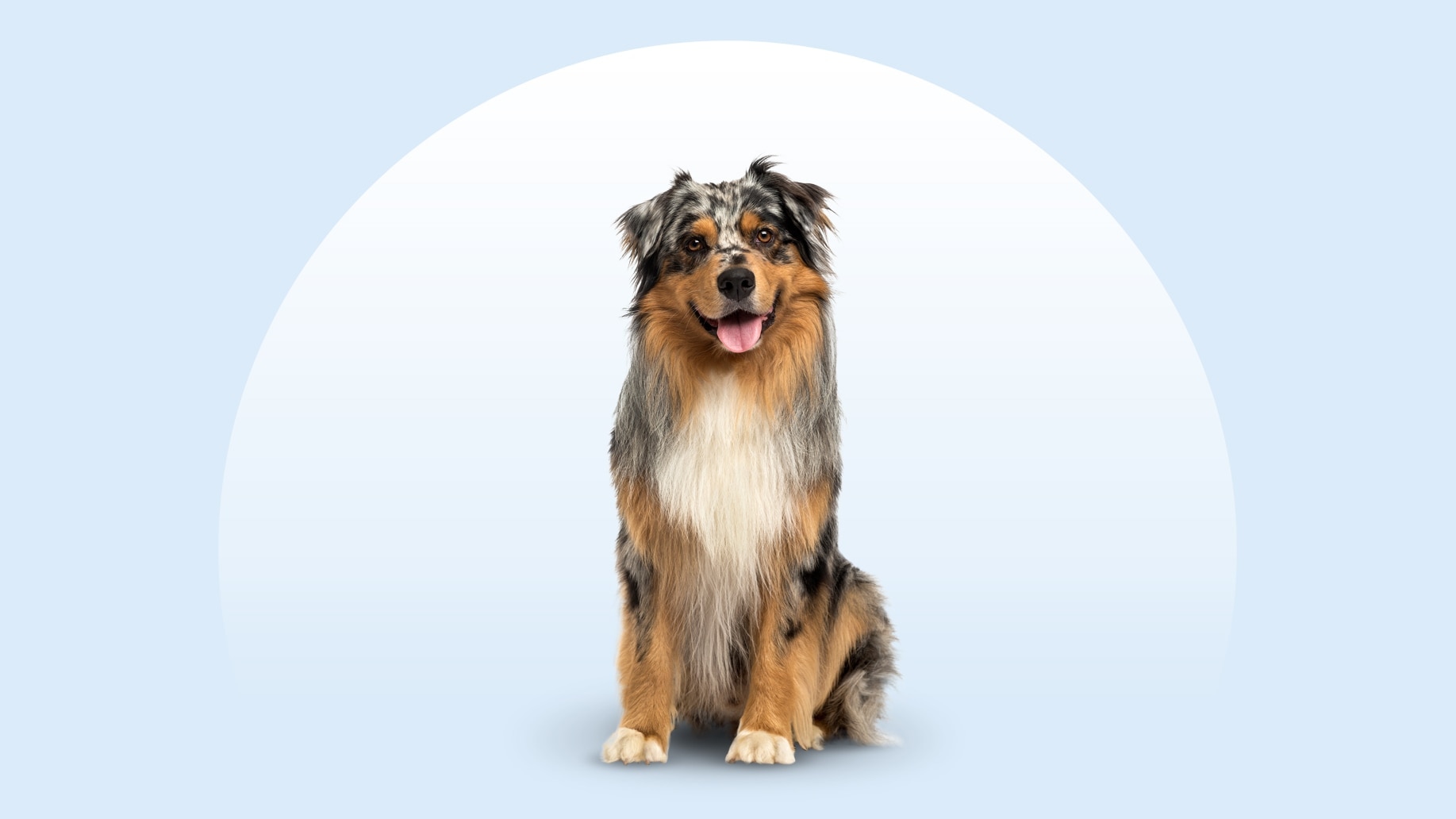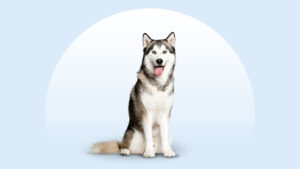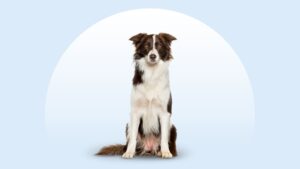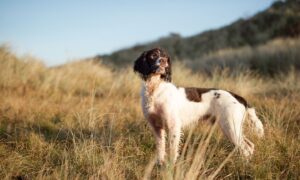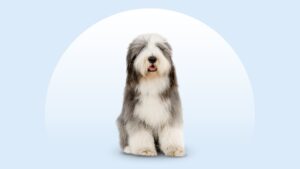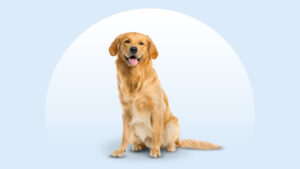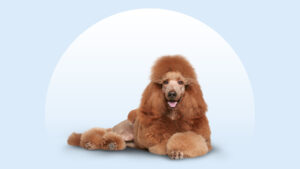Australian Shepherd
Updated June 16, 2025
Australian Shepherd
Updated June 16, 2025
Bright and energetic, Australian Shepherds excel with active pet parents who have the time to train them. Your Aussie will thrive if they have plenty of space, lots of exercise, and the opportunity to engage in physical activity that also puts their mind to work, such as obedience or agility training.
All-Day Energy, Up-for-Anything Sidekick, Intelligent
40–65 pounds
18–23 inches
12–15 years
Blue Merle, Black, Red, Red Merle
If you’re really into working out and won’t stop talking about it (no judgment), there’s a dog out there who’s just as competitive and sporty as you are. As the MVP of the dog park, the Australian Shepherd (or “Aussie”) loves playing fetch, running agility courses, and any activity that unleashes their playful side.
Australian Shepherds are intelligent, energetic pups that need pet parents with the time to teach them new tricks, go on long walks or hikes, and invest in fun activities you can do together, like agility trials or even a SUP session.
Australian Shepherd Characteristics
Australian Shepherd Appearance
The Australian Shepherd has a striking gaze, a fluffy double coat, a lean body, and a tail that’s either bobbed, docked, or long and furry. Their eyes can be many colors, but they’re often light blue and occasionally mismatched. The Aussie’s coat color can also vary.
While there’s no kennel club that recognizes a “mini” version of the Australian Shepherd; the American Kennel Club (AKC) does recognize a separate breed called the Miniature American Shepherd, which is smaller and has a distinct breed standard.
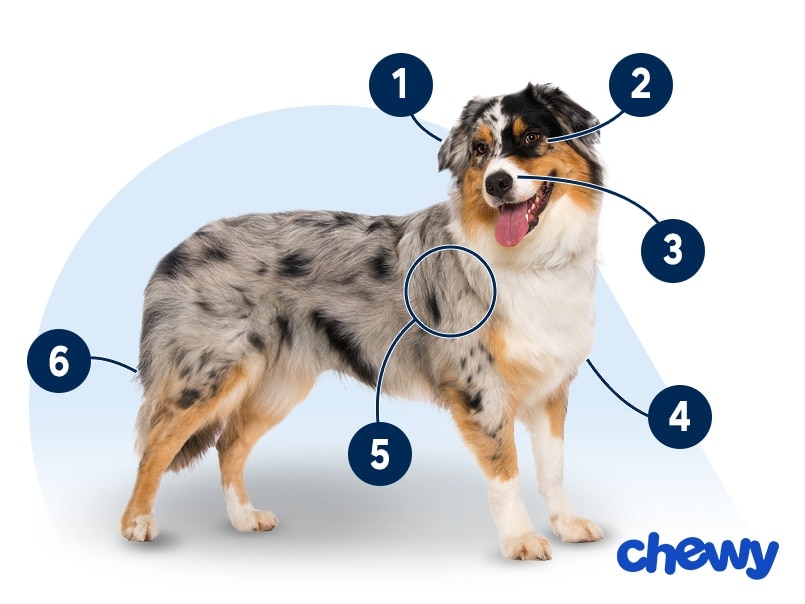
- Ears
The Australian Shepherd's alert ears are triangular with a natural fold and set high on their head.
- Eyes
Their eyes are brown, blue, amber, or a combination; sometimes each eye is a different color.
- Nose
Aussie noses are straight with a rounded black or brown tip. Merle Australian Shepherds may have pink spots on their nose.
- Coat Length
An Australian Shepherd’s medium-length double coat has two layers: a soft, insulating undercoat and a thick, water-resistant outer coat. They have feathering on the back of their legs.
- Coat Color
Australian Shepherd colors include black, blue merle, red, or red merle, all with possible tan or white markings.
- Tail
Traditionally, the Australian Shepherd tail was docked when they were still a puppy. However, it’s becoming more common to keep the breed’s naturally fluffy, long tail intact. Many groups, including the American Veterinary Medical Association, now oppose tail docking for welfare reasons, and many countries as well as U.S. states have banned the practice. But some Aussie dogs carry the bobtail gene, which means they’re born with a stubby tail or none at all.
Australian Shepherd Temperament
Australian Shepherds were bred to herd. As such, they’re fast, smart, and always on the move, so other outlets for their robust energy are a must.
Because Aussies have a natural herding instinct, they may try to round up unsuspecting children or surprised neighbors out on a bike ride. It’s wise to train your dog early so they understand how to behave in polite society. Be sure to keep your pup on a leash or within a securely fenced area—these dogs are speedy.
Feed their natural curiosity with daily training sessions that engage their mind and body. Aussies genuinely want to make you happy, and this dedicated time together will deepen your bond.
Playtime is another way to blow off some energy. Australian Shepherds will enthusiastically engage in just about any game you can invent. Most adore playing fetch, and they have a well-deserved reputation as disc dog champions.
Your Aussie’s bubbly personality might make you think they’re a social butterfly, but they tend to be cautious around strangers. Properly socializing an Australian Shepherd puppy will help them feel more comfortable in new environments when they’re older.
Bottom line: Aussies dislike downtime (except when they’re sleeping!), so keep them entertained with lots of outdoor time and toys, such as interactive puzzles, flying discs, and balls.
How to Care for a Australian Shepherd
As hearty dogs originally bred for life on the farm or ranch, Aussies are relatively rough-and-tumble pups that need outlets for their high energy, sharp minds, and desire to do things. A healthy Aussie is an active Aussie, so make sure to keep them moving no matter the weather or your schedule.
Grooming
Training
Diet
Exercise
Environment
Australian Shepherd Health
The Australian Shepherd lifespan is about 12–15 years, and it’s not unusual for an Aussie to live to be 16. However, there are a few common health issues in this breed to be aware of.
- Cancer: Aussies have an increased risk of some cancers, particularly lymphoma and hemangiosarcoma, a cancer from the cells that line the blood vessels. Let your vet know if you notice any unusual lumps (although some growths can be internal), and keep in mind they could be benign.
- Epilepsy: A neurological disorder defined by seizures, epilepsy can be an inherited condition in Aussies. There are no genetic screening tests, but often the condition can be controlled with daily, lifelong medication. See a vet immediately if your dog has a seizure.
- Eye issues: Cataracts are the most common eye disease in Aussies, but they’re also at risk of collie eye anomaly (CEA), a hereditary disease of the nerve and eye tissue that ultimately leads to blindness. Aussies are also susceptible to distichiasis, in which an eyelash grows abnormally, scratching the eye.
- Hip dysplasia: Hip dysplasia is a painful genetic condition where the ball of the femur doesn’t properly fit into the hip socket. Obesity can make symptoms worse, so a healthy diet and regular exercise are crucial.
- Multidrug resistance 1 (MDR1) mutation: MDR1 is a genetic mutation commonly found in herding breeds and can be detected via genetic testing. This mutation makes dogs more sensitive to some medications, particularly the popular drug ivermectin, which is found in heartworm prevention. Always consult your vet about the right medication for your pet.
Take your dog for regular checkups so you and your vet understand your Aussie’s healthy “normal.” This can help you better identify when your Aussie behaves abnormally.
Australian Shepherd History
Surprisingly, the Aussie’s story begins not in Australia but in the Basque region of Spain, near the Pyrenees mountains that divide Spain and France. There, herdsmen selectively bred the ancestors of the beloved Aussie for their herding abilities.
As people from the Basque region settled in Australia during the 19th century, they brought these working dogs with them. Over time, the dogs were bred with other herding dogs, like Border Collies, and found homes on Australian ranches.
As migration progressed to the American West, the dogs found footing in California, where locals mistakenly assumed Australia was their place of origin. California ranchers admired these dogs for their work ethic and exceptional herding abilities.
The AKC recognized the Australian Shepherd dog breed in 1991. Today, they are still found on ranches and farms worldwide. Not only are they great additions to high-energy families, but Aussies can also work as service or therapy dogs, as well as in jobs like search and rescue.
A purebred Australian Shepherd puppy can cost anywhere from $600 to $2,000 or more. If you choose this route, pick a responsible breeder.
You can also adopt an Australian Shepherd rescue dog by:
- Reaching out to organizations, such as Aussie Rescue and Placement Helpline, a nationwide network of Australian Shepherd rescues
- Keeping an eye out for the breed at your local animal shelter or on their social media
- Searching Chewy’s database of adoptable dogs in your area.
